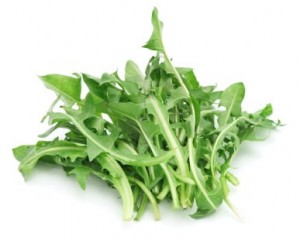 The days are getting longer, the weather is getting warmer, and flowers are starting to bloom in our area of northern California. These are sure signs that spring will be here shortly. One of the many things that I appreciate about spring is the availability of spring greens from my local farmer’s market, natural food store, and my own backyard garden. One popular ingredient in spring green mixes is dandelion greens. I personally love dandelion greens year round, and enjoy them in my salads, smoothies, and juices. I especially appreciate dandelion greens when they are young, since their flavor is less bitter than when they are more mature. Dandelion greens are in the sunflower plant family (Asteraceae), along with lettuce, endive, escarole, frisée greens, sunflower seeds, and Jerusalem artichokes. The name for this plant has an interesting origin. I remember from a college botany class that the name “dandelion” was derived from the French “dent de lion” meaning “tooth of the lion” or “lion’s tooth”, due to the somewhat jagged tooth-like appearance of dandelion greens. The mineral content of dandelion greens is notable:
The days are getting longer, the weather is getting warmer, and flowers are starting to bloom in our area of northern California. These are sure signs that spring will be here shortly. One of the many things that I appreciate about spring is the availability of spring greens from my local farmer’s market, natural food store, and my own backyard garden. One popular ingredient in spring green mixes is dandelion greens. I personally love dandelion greens year round, and enjoy them in my salads, smoothies, and juices. I especially appreciate dandelion greens when they are young, since their flavor is less bitter than when they are more mature. Dandelion greens are in the sunflower plant family (Asteraceae), along with lettuce, endive, escarole, frisée greens, sunflower seeds, and Jerusalem artichokes. The name for this plant has an interesting origin. I remember from a college botany class that the name “dandelion” was derived from the French “dent de lion” meaning “tooth of the lion” or “lion’s tooth”, due to the somewhat jagged tooth-like appearance of dandelion greens. The mineral content of dandelion greens is notable:
| 4 cups chopped dandelion greens (220 g) | Adult Daily Values | |
| Calories | 99 kcal | |
| Calcium | 411.40 | 1000 – 1200 mg |
| Iron | 6.82 | 8 – 18 mg |
| Zinc | 0.90 | 8 – 11 mg |
| Potassium | 873.4 | 4700 mg |
| Magnesium | 79.2 | 310 – 420 mg |
As one can see, the leaves of this plant that is often regarded as a garden weed, actually has significant nutritional value! Additionally, the protein content of 4 cups of chopped dandelion greens is almost 6 grams.
One of the best ways to keep in touch with us is to join our email list. You’ll receive a free copy of Our Top 12 Strategies for Long Term Success on A Raw Plant-Based Diet eBook along with regular information about raw food and plant-based diets and periodic promotions for our classes, events, and other offerings!
